Key takeaways:
- Inclusive teaching fosters a sense of belonging by valuing diverse backgrounds and experiences, which enriches classroom discussions and empathy among students.
- Implementing collaborative learning and multimedia resources enhances student engagement and understanding in religious education.
- Challenges to inclusivity, such as differing comfort levels with topics and time constraints, require adaptability and patience from educators.
- Creating a safe space for all voices, enabling personal narratives, and self-reflection on biases are essential for fostering true inclusivity in the classroom.
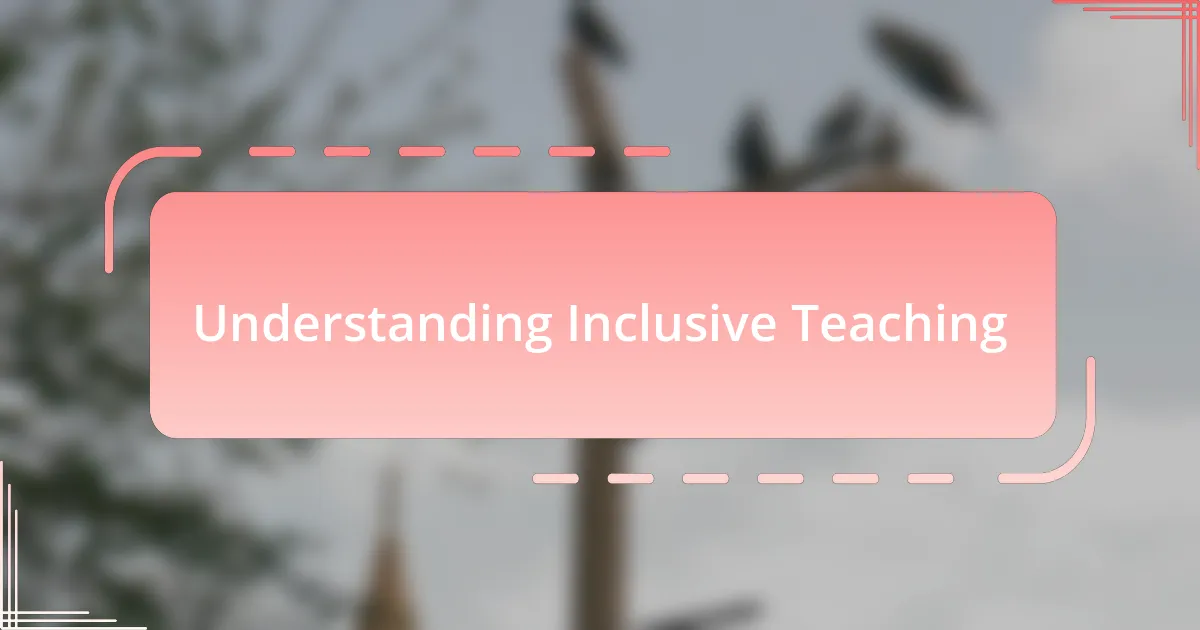
Understanding Inclusive Teaching
Inclusive teaching is about creating a learning environment where all students feel valued and included, regardless of their background or abilities. I remember my first experience with inclusive teaching in a classroom where a student with a hearing impairment shared their perspective on a lesson. That moment made me realize how vital it is to adapt our approaches to meet diverse needs—after all, shouldn’t every voice have a chance to contribute?
When I reflect on the principles of inclusive teaching, I often ask myself how well we understand the different barriers that students face. I once witnessed a classroom debate where students from various cultural backgrounds brought rich insights to the table. It struck me that by embracing this diversity, we not only enrich the educational experience but also foster empathy and understanding among peers. Isn’t it amazing what we can learn from one another?
Moreover, at its core, inclusive teaching requires a mindset shift. Instead of viewing differences as challenges, we can see them as strengths that enhance our collective learning. I recall a project where students collaborated on a community service initiative. Their unique perspectives led to creative solutions, proving that inclusivity not only helps individual students but can also elevate the entire class. Have you considered how your own experiences might shape your understanding of inclusive practices?
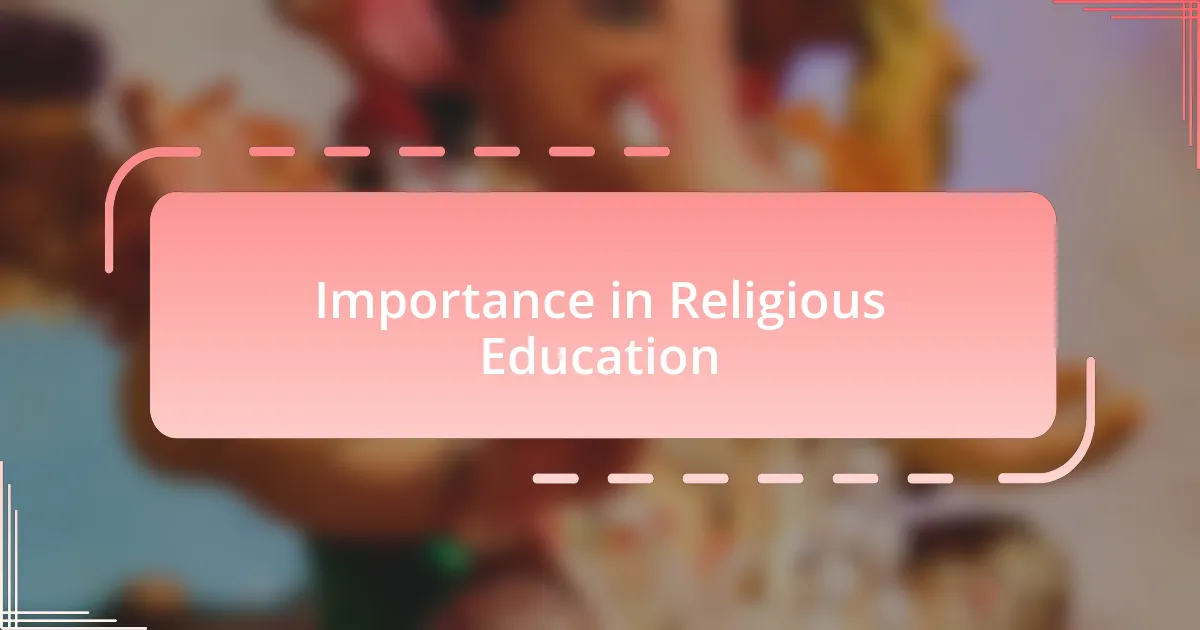
Importance in Religious Education
Inclusive teaching plays a crucial role in religious education as it creates a space where students can explore their beliefs in a supportive environment. I recall a lesson where students were encouraged to share their spiritual experiences, leading to open discussions about different faiths and practices. This exchange not only deepened our understanding of each religion but also fostered respect and compassion among classmates. Isn’t it interesting how a simple classroom conversation can turn into a profound learning journey?
In religious education, inclusive teaching allows students to feel comfortable expressing their beliefs, which can be deeply personal. I remember a student who practiced a minority religion, hesitating to participate in discussions. When she finally shared her perspectives, her insights illuminated aspects of the faith that many were unaware of. This experience highlighted how inclusivity can empower voices that often go unheard, leading to richer conversations around religion. How might we all benefit from being more attuned to these diverse narratives?
Additionally, inclusive teaching in religious education nurtures critical thinking and reflection. I once facilitated a project that involved researching various religions and their core values. Students came to appreciate the nuances of different beliefs and, through this exploration, developed a greater sense of empathy towards their peers. It made me wonder—what if every lesson in religious education could spark such meaningful exchanges that challenge our assumptions?
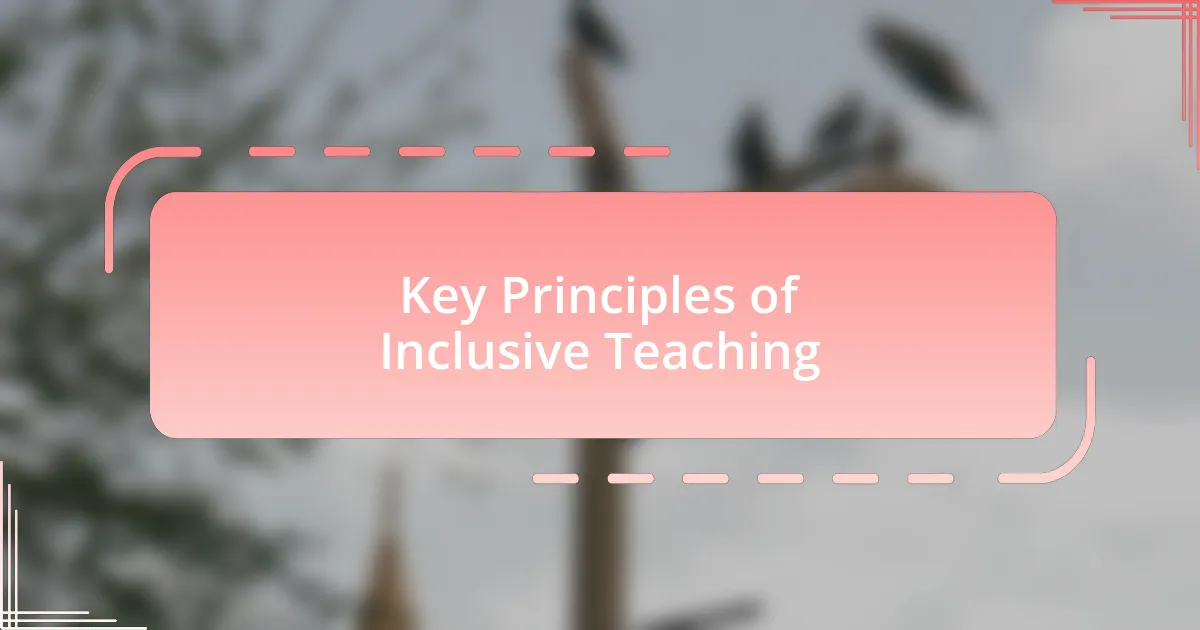
Key Principles of Inclusive Teaching
Key Principles of Inclusive Teaching
One essential principle of inclusive teaching is recognizing and valuing the diverse backgrounds of students. In my experience, when I took the time to learn about my students’ cultural and religious identities, it transformed the dynamics of the classroom. I remember a moment when a student shared a traditional festival from their culture, prompting others to ask questions and share their own experiences. This not only enhanced our discussions but also made every student feel seen and appreciated. How often do we overlook these rich conversations that can arise from simply acknowledging our differences?
Another critical element is differentiated instruction, which tailors lessons to meet the varied needs of students. I once implemented a lesson where students could choose between several formats—like a presentation, an art project, or a written reflection—to express their understanding of a religious text. Observing the excitement on their faces as they engaged with the material in ways that resonated with them was truly rewarding. It reinforced my belief that when education is adaptable, it becomes more effective and inclusive. Isn’t it fascinating how giving students choices can spark creativity and understanding?
Lastly, fostering an environment of open dialogue is vital in inclusive teaching. I encourage my students to share their opinions and challenge ideas respectfully. There was a time when a debate about ethical dilemmas in different religions led to passionate but constructive discussions, where even the quieter students began to voice their thoughts. It made me reflect on how crucial it is to create spaces where every opinion matters, as this cultivates a deeper connection to the subject. Have you ever experienced a moment where an unexpected student voice changed the entire direction of a conversation?
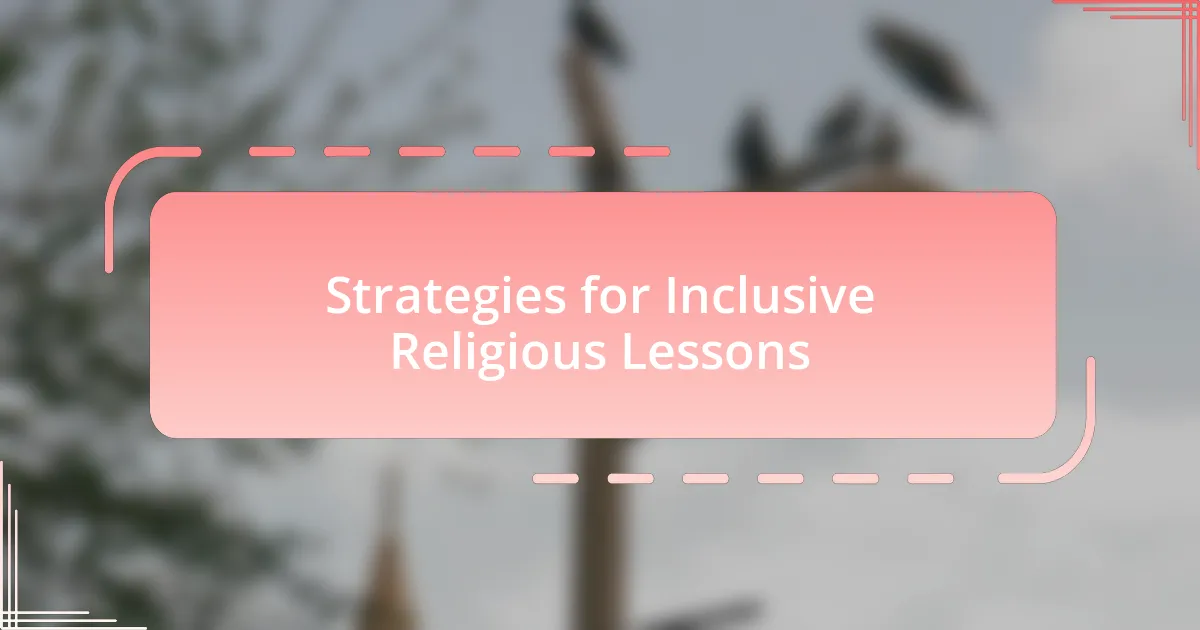
Strategies for Inclusive Religious Lessons
One effective strategy for inclusive religious lessons is the use of collaborative learning. I remember a group project I organized where students worked together to create a presentation on different religious beliefs regarding charity. What struck me was how the group dynamic allowed students to share their own backgrounds and hear differing perspectives. By working side by side, they fostered a sense of belonging that enriched the topic. Isn’t it interesting how cooperative efforts can help bridge gaps and build relationships among students?
Another strategy that has proven successful is integrating multimedia resources. For instance, when I introduced videos from various cultural ceremonies and online discussions of religious themes, it opened up a world of understanding for my students. One student remarked how it made them feel connected to traditions they previously thought were foreign. It highlights the power of visual storytelling in making lessons relatable and accessible. How often do we underestimate the impact of visuals in conveying complex ideas?
Also, providing accommodations for students with varying needs can significantly enhance inclusion. I once had a student who struggled with traditional reading methods. By offering audiobooks and visual aids about religious texts, I observed their engagement soar. They not only grasped the material better but also felt valued in the learning environment. Doesn’t this illustrate how small adjustments can make a monumental difference in fostering inclusivity?

Challenges in Implementing Inclusivity
Implementing inclusivity in the classroom often reveals underlying challenges that can be difficult to navigate. I recall a time when I tried to incorporate diverse religious viewpoints into a discussion. While my intention was to create an open environment, some students expressed discomfort with topics that clashed with their beliefs. This moment made me realize that inclusivity sometimes requires addressing deeply held values and finding common ground, which isn’t always easy.
Another challenge I faced involved varying levels of familiarity with religious concepts among students. In one class, I introduced a complex idea that resonated with some, while others seemed lost. I had to adapt quickly, breaking down the material to accommodate different levels of understanding. This experience taught me that fostering inclusivity often hinges on patience and the willingness to pivot when the learning atmosphere isn’t as supportive as I hoped.
Additionally, time constraints can be a formidable barrier to inclusivity. In my experience, I frequently find myself rushed to cover required content, which limits opportunities for deeper engagement. It begs the question: how can we balance curriculum demands with the richness that inclusivity brings? Allowing for flexibility in lesson planning could open doors to discussions that help students feel acknowledged and respected, but it requires a commitment that not all educators can easily make.
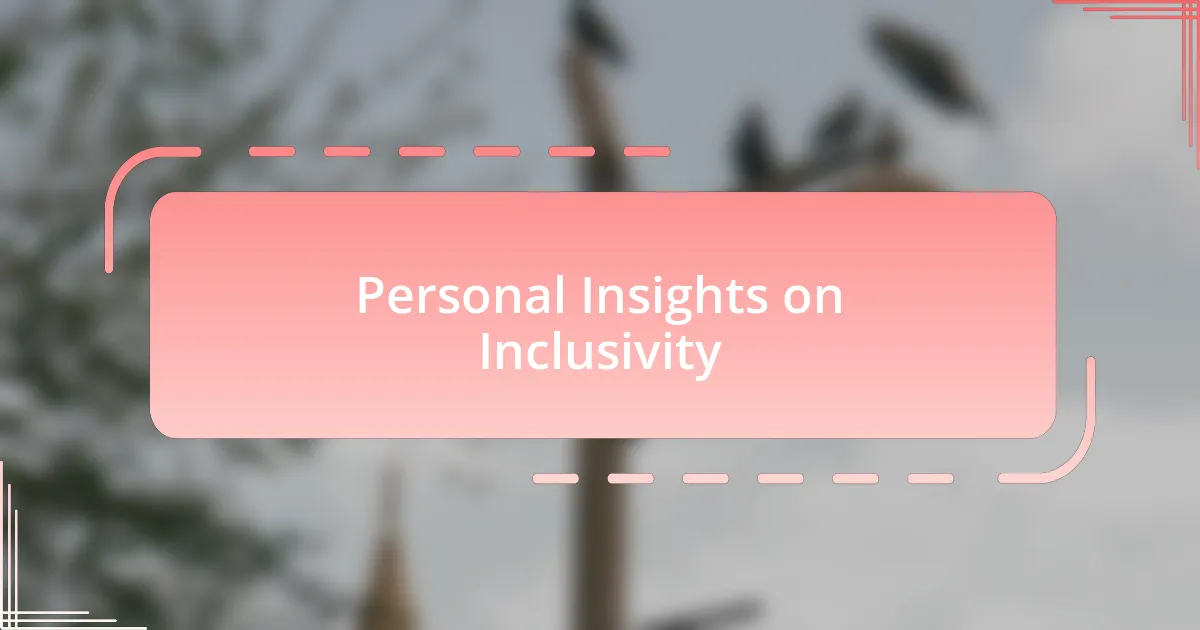
Personal Insights on Inclusivity
When I first embraced the concept of inclusivity in my teaching, I didn’t fully grasp its emotional depth. I remember a particular lesson where we explored an important religious text. Some students felt empowered to share their insights, while others sat in silence, visibly uncomfortable. This disparity highlighted an essential truth: inclusivity isn’t just about diverse voices; it’s about creating a safe space where everyone feels brave enough to speak.
I often reflect on how important it is to engage not just the minds but the hearts of students. One day, during a discussion on morality across religions, a student shared a personal story about discrimination they faced due to their beliefs. Witnessing the shift in the room, I understood how vulnerabilities can unite us, fostering empathy and solidarity. After all, who doesn’t crave understanding in an increasingly polarized world?
Navigating the nuances of inclusivity has taught me to be a more attentive listener and facilitator. I’ve encountered times when seemingly simple questions could lead to profound revelations. That moment of hesitation before the question is asked can hold so much weight. I often think, what if we viewed those pauses not as uncomfortable silences, but as opportunities for growth? Embracing these moments has transformed my approach, reminding me that every voice deserves to be heard and respected.
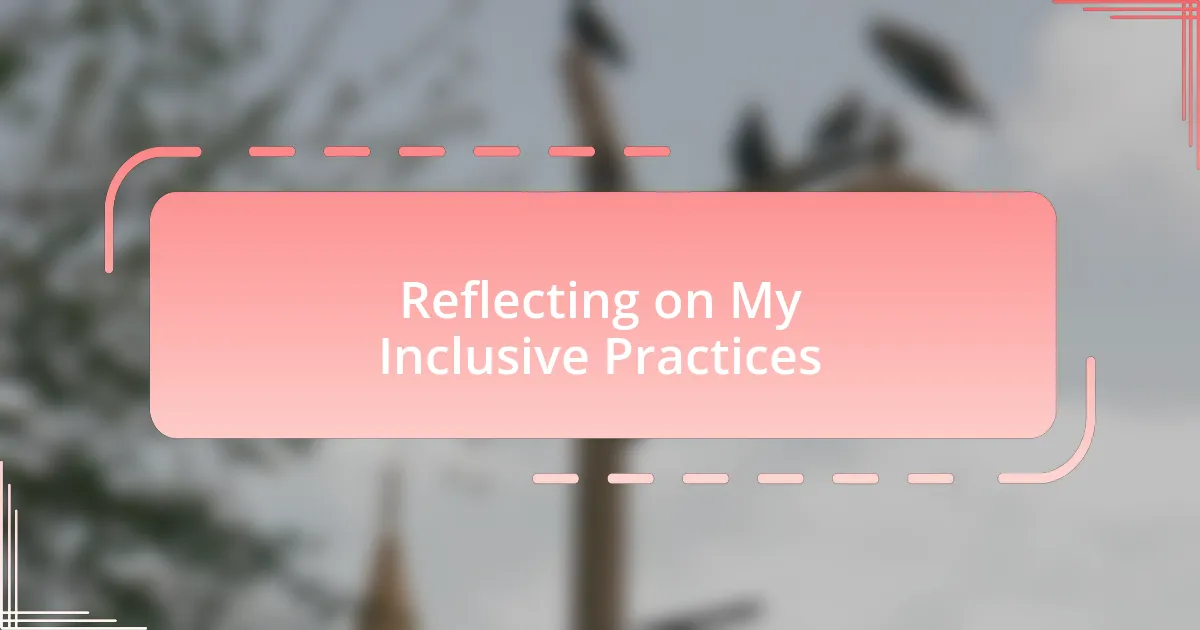
Reflecting on My Inclusive Practices
Reflecting on my inclusive practices often leads me back to that moment when a quiet student surprised us all during a lesson on compassion in different faiths. They spoke softly but passionately about their experiences during family gatherings, where their beliefs felt marginalized. It struck me how profoundly personal narratives can illuminate the collective understanding; I realized that creating a space for these stories is essential for a truly inclusive environment.
I occasionally find myself thinking about the students who may not yet feel comfortable sharing their perspectives. How often have I inadvertently overlooked their potential voices? This thought resonates within me, prompting me to consider strategies that encourage contributions from everyone, especially those who may typically blend into the background. After all, isn’t the core of teaching to inspire a dialogue that includes all viewpoints?
Each interaction offers new insights into my role as a facilitator of inclusive discussion. I recall an instance when a student challenged me with a question about religious stereotypes, pushing me to reflect not just on my teachings but on my own biases. How can I stimulate conversations that dismantle misconceptions? This continual self-examination is crucial; it reminds me that being inclusive is not a one-time effort but a lifelong commitment to learning and growing alongside my students.